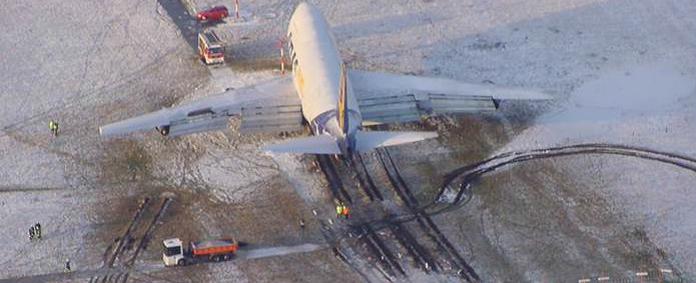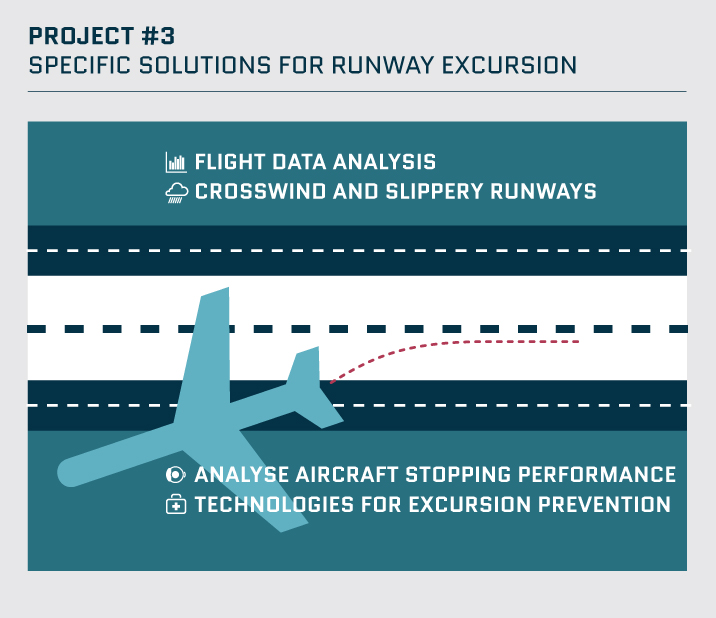Project #3
Specific solutions for runway excursion accidents
Type of Project
Collaborative Project
Theme
New Solutions for Today's Accidents
What is Project #3 about?
The objective of P3 is to perform breakthrough safety research, in accordance with the European Action Plan for the Prevention of Runway Excursions (EAPPRE) priorities, to enable a significant reduction of runway excursion risk in the medium term. The EAPRRE has identified areas where non-ATM research is needed to further reduce runway excursion risk:
- Flight mechanics of ground operations on slippery runways under crosswind conditions;
- Impact of fluid contaminants of varying depth on aircraft stopping performance;
- Advanced methods for analysis of flight data to monitor runway excursion risk factors.
The results of the research will further improve the knowledge on runway excursion prevention and risk mitigation. It is therefore expected that this will contribute to an additional reduction in the number of runway excursion accidents, incident and occurrences.
P3 addresses Theme 1 “New solutions for today’s accidents” that deals with the two accident categories comprise over half of the fatalities in worldwide commercial air transport: Loss of Control in flight and Runway Excursions. It may be expected that progress here will have a major impact on the fatality rate.
Project Manager: NLR

P3 “Specific solutions for runway excursion” is divided in 4 Work Packages.
WP3.1 – Crosswind and slippery runways
This WP develops the best methods for analysing ground control on slippery runway under crosswind and validates them through flight testing. The main objectives are to identify shortcomings in current modelling of aircraft ground control under crosswind and on slippery runway, and to improve methods for analysing aircraft ground control on slippery runways under crosswind so that more consistent/accurate crosswind guidance material from the manufacturers can be developed.
WP3.2 – Research on the impact of fluid contaminants of varying depth on aircraft stopping performance
This WP studies impact of modern aircraft tires and modern anti-skid systems on stopping performance of aircraft on contaminated runways, to gain insight into the impact of water/slush covered runways on braking performance. The following tasks are identified:
- Review the state of current knowledge (literature study) regarding tyre braking performance, anti-skid systems and modern aircraft tyres;
- Flight testing/laboratory ground testing of the braking performance modern aircraft tyres and aircraft on water covered runways;
- Comparison of results with data used for performance calculation and certification means of compliance.
WP3.3 studies and develops algorithms that can be used to analyse flight data for runway veer-off excursion risk factors. The following tasks are identified:
- Identification of veer-off risk factors (analyses of accidents/incidents);
- Identification, collection and analyses of relevant data like flight data, meteo data, aircraft performance/stability data, runway data etc.
- Define algorithms that can identify veer-off risk factors.
This WP will explore new concepts for the prevention of runway excursions and/or the reduction of the consequences of runway excursions. These concepts will include both aircraft (on-board) technology and airport based systems. The following tasks are identified:
- Inventory of current developments and new initiatives;
- Feasibility study and definition of R&TD needed for implementation of new concepts;
- Assess impact of the new concepts on reducing excursions (no cost-benefit).
This Project is expected to contribute to a further reduction in the number of runway excursion accidents, incidents and occurrences. This will obviously improve safety. Because runway excursions usually result in disturbances in the operational process, the improved understanding of will also result in increased punctuality and reduced costs.
P3 is expected to produce/develop:
- New tools and data to support pilot decision making process when operating on wet/contaminated runways;
- New data and tools for certification of transport aircraft on wet/contaminated runways;
- New technologies to reduce runway excursion risk;
- New tools to be used with flight data monitoring.






